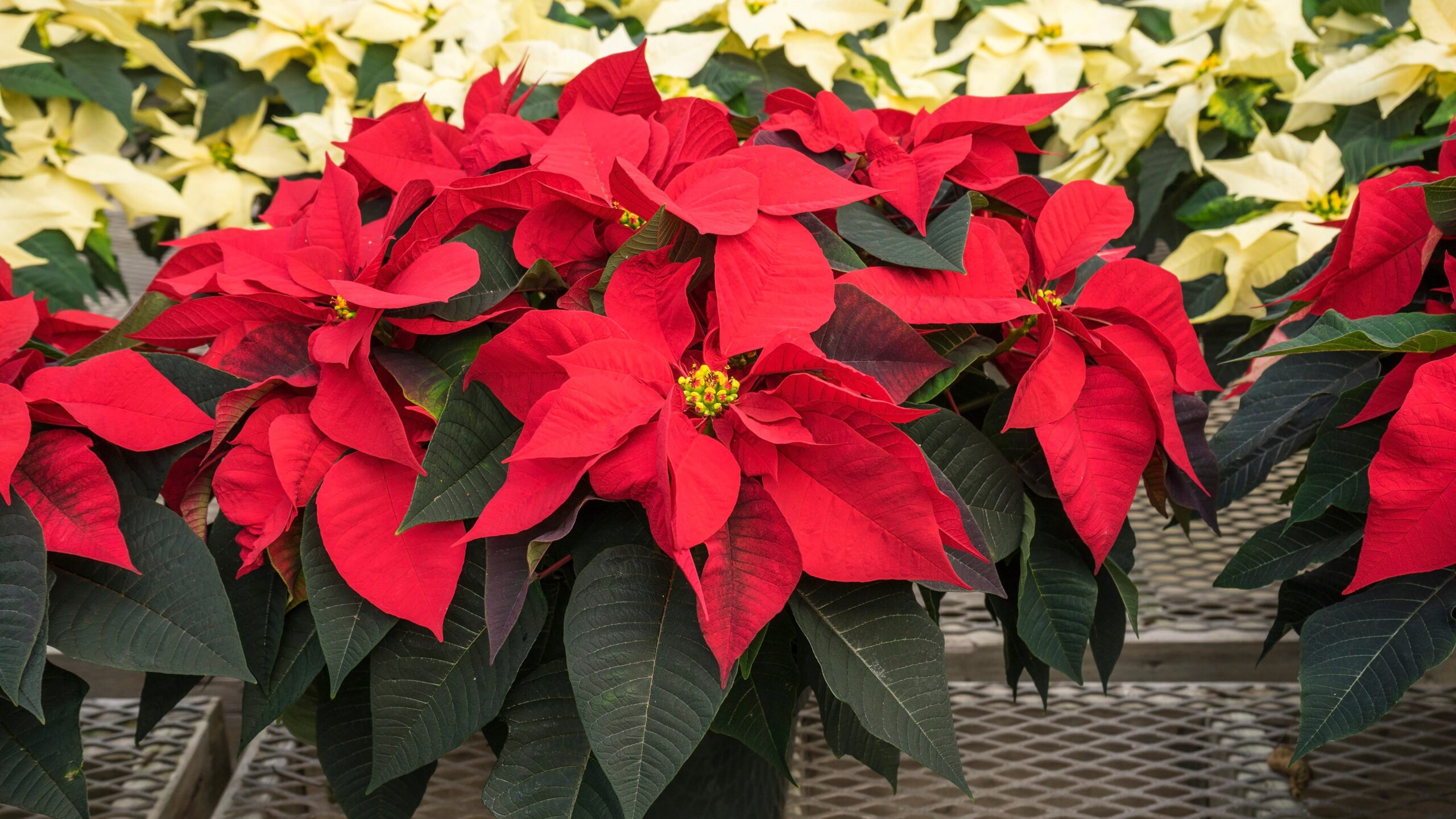No plant heralds the festive season quite like the poinsettia. With its vivid red, pink, or creamy white bracts (modified leaves often mistaken for petals), this iconic plant brings cheer and elegance to homes around the world during the winter holidays. Native to Mexico, where it’s known as Flor de Nochebuena, the poinsettia has a rich cultural history and symbolic significance, representing purity, celebration, and goodwill.
Its beauty is unmistakable, but caring for it properly ensures it lasts well beyond the holidays. Let’s explore the distinctive features and care of this striking plant so you can enjoy its seasonal magic to the fullest.

Portrait of the Poinsettia
Belonging to the Euphorbiaceae family, the poinsettia (Euphorbia pulcherrima) hails from Mexico and Central America. In its natural habitat, it grows as a perennial shrub, reaching heights of up to 3 metres (10 feet). It gained popularity in the 19th century when U.S. ambassador Joel Roberts Poinsett introduced it to North America—hence the name.
The vivid red “flowers” are actually bracts—specialized leaves that change color in response to shorter daylight hours. The true flowers are the small, yellow cyathia at the center of the bracts.
Foliage and Form
Poinsettias feature broad, pointed, deep green leaves arranged spirally along upright stems. As the days shorten, the uppermost bracts shift from green to red, pink, cream, or variegated tones depending on the cultivar.
They are typically compact and bushy when cultivated for indoor use, although they can grow into substantial shrubs in tropical climates.
Blooms and Bracts
The real charm of the poinsettia lies in its colorful bracts, which provide the illusion of large, vivid flowers. Available in a spectrum of reds, whites, marbled pinks, and apricots, these bracts form a crown of festive color.
The tiny, yellow central flowers (cyathia) signal peak bloom—once they begin to drop, the bracts will slowly fade. With careful treatment, however, the plant can be coaxed to bloom again the following year.
The Right Time to Plant and Care for Poinsettias
Poinsettias are seasonal bloomers and are generally purchased in full color during winter. They can be kept as houseplants year-round and even planted outdoors in frost-free climates.
| Month | Planting | Flowering |
|---|---|---|
| January | ❌ (too cold outdoors) | ✅ (indoor color display) |
| February | ❌ | ✅ |
| March | ❌ | ❌ (color fades) |
| April | ✅ (repot indoor plant) | ❌ |
| May | ✅ (outdoor in warm zones) | ❌ |
| June | ✅ | ❌ |
| July | ✅ | ❌ |
| August | ✅ | ❌ |
| September | ❌ (begin dark treatment) | ❌ |
| October | ❌ | ❌ |
| November | ❌ | ✅ (color begins to return) |
| December | ❌ | ✅ (peak display) |
✅ = Recommended ❌ = Not advised
Ideal Watering, Sunlight, and Environment for Poinsettias
Watering
Poinsettias like moderate, consistent moisture. Water thoroughly when the top inch of soil is dry, but do not let them sit in standing water. Overwatering leads to root rot, while underwatering causes leaf drop. Remove decorative foil sleeves or poke holes to ensure good drainage.
Sunlight
These plants prefer bright, indirect light indoors. Too much sun can scorch their leaves, while too little will result in dull color and leaf loss. A south or east-facing window with filtered light is ideal.
Indoor vs Outdoor
Poinsettias are primarily indoor plants in temperate regions. In frost-free tropical and subtropical areas, they can be planted outdoors as perennial shrubs. Indoors, they do best in a stable, warm environment away from cold drafts or heat vents.
Temperature
Poinsettias thrive in temperatures between 18–22°C (65–72°F). Avoid exposing them to temperatures below 10°C (50°F). They are highly sensitive to cold and sudden temperature changes.
Ideal Soil Conditions for Growing Poinsettias
| Soil Feature | Optimal Condition | Why It Matters |
|---|---|---|
| Soil Type | Light, loamy, well-draining potting mix | Prevents waterlogging and allows root aeration |
| Texture | Fine and crumbly with organic matter | Supports healthy root structure and moisture balance |
| Drainage | Excellent drainage necessary | Avoids root rot, especially in decorative indoor pots |
| Moisture | Evenly moist—not soggy | Prevents leaf drop and maintains bract color |
| Soil pH | Slightly acidic (5.5–6.5) | Optimizes nutrient availability |
| Amendments | Compost, perlite, peat | Improves structure and holds moisture without compaction |
Common Problems & Solutions
| Issue 🐾 | Symptoms 🔍 | Solutions 🛠️ |
|---|---|---|
| Leaf Drop 🍃 | Sudden loss of leaves | Avoid drafts, keep temperatures steady, maintain proper watering |
| Root Rot 💧 | Wilting, blackened roots, foul smell | Remove affected roots, repot in fresh mix, reduce watering |
| Whiteflies 🦟 | Tiny insects under leaves, sticky residue | Use yellow sticky traps, neem oil, or insecticidal soap |
| Faded Bracts 🎨 | Dull or greenish bracts | Ensure bright light, proper temperature, and no overwatering |
| Failure to Re-bloom 🌒 | No color change the next year | Provide 14–16 hours of darkness daily from Sept–Nov for 8 weeks |
Poinsettias are much more than a holiday centerpiece—they are vibrant, living plants that can bring beauty throughout the year when properly nurtured. With light, warmth, and careful seasonal care, they will grace your home with brilliant color and elegant structure long past the festive season.